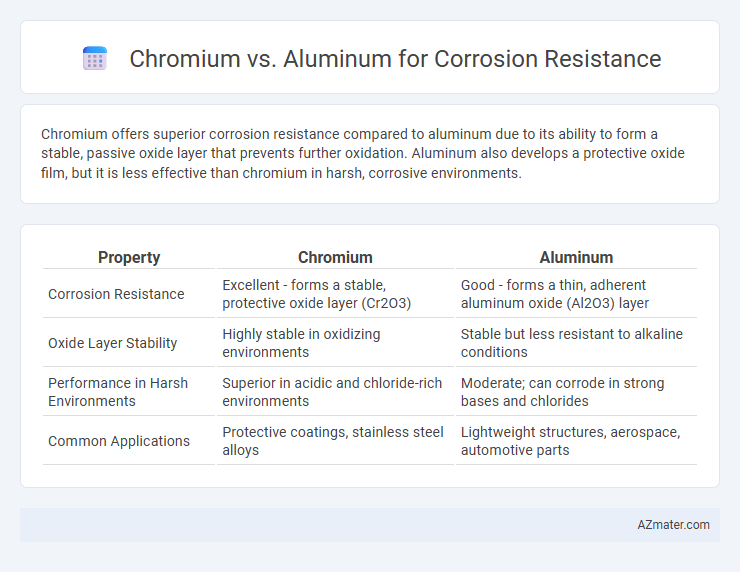Chromium offers superior corrosion resistance compared to aluminum due to its ability to form a stable, passive oxide layer that prevents further oxidation. Aluminum also develops a protective oxide film, but it is less effective than chromium in harsh, corrosive environments.
Table of Comparison
| Property | Chromium | Aluminum |
|---|---|---|
| Corrosion Resistance | Excellent - forms a stable, protective oxide layer (Cr2O3) | Good - forms a thin, adherent aluminum oxide (Al2O3) layer |
| Oxide Layer Stability | Highly stable in oxidizing environments | Stable but less resistant to alkaline conditions |
| Performance in Harsh Environments | Superior in acidic and chloride-rich environments | Moderate; can corrode in strong bases and chlorides |
| Common Applications | Protective coatings, stainless steel alloys | Lightweight structures, aerospace, automotive parts |
Overview of Chromium and Aluminum
Chromium exhibits exceptional corrosion resistance due to its ability to form a stable, passive oxide layer that protects underlying metal from oxidation and environmental damage. Aluminum naturally develops a thin, durable oxide coating that prevents further corrosion and maintains structural integrity in various atmospheric conditions. Both metals are widely used in industries requiring corrosion resistance, with chromium often utilized in stainless steel alloys and aluminum favored for lightweight, corrosion-resistant applications.
Defining Corrosion Resistance
Corrosion resistance refers to a material's ability to withstand degradation caused by environmental interactions such as oxidation, moisture, and chemical exposure. Chromium enhances corrosion resistance by forming a stable, passive oxide layer that protects the underlying metal from rust and deterioration. Aluminum naturally develops a thin oxide coating that acts as a barrier to corrosion, making it highly resistant to atmospheric and aqueous environments without requiring additional treatment.
Chemical Properties Influencing Corrosion
Chromium offers superior corrosion resistance due to its ability to form a stable, compact chromium oxide (Cr2O3) layer that protects underlying metals from oxidation and environmental damage. Aluminum also develops a protective aluminum oxide (Al2O3) layer, but this layer is generally less dense and more susceptible to breakdown in highly acidic or alkaline conditions. The chemical stability and passivation properties of chromium oxide result in enhanced durability and resistance to corrosive agents compared to aluminum oxide.
Natural Oxide Layers: Chromium vs Aluminum
Chromium forms a dense and stable chromium oxide (Cr2O3) layer that provides superior corrosion resistance by preventing further oxidation and protecting the underlying metal. Aluminum develops a thin but highly adherent aluminum oxide (Al2O3) layer that effectively resists corrosion, especially in atmospheric conditions, due to its self-healing properties when damaged. While both oxide layers offer protective barriers, chromium oxide is generally more resistant to chemical attack, whereas aluminum oxide excels in environments with exposure to moisture and air.
Performance in Different Environments
Chromium offers superior corrosion resistance in highly acidic and saline environments due to its ability to form a stable, protective oxide layer that prevents further oxidation. Aluminum performs well in oxidizing conditions and resists corrosion in atmospheric and marine environments but may suffer pitting corrosion in chloride-rich media. In industrial applications, chromium-enhanced alloys typically demonstrate better durability in harsh chemical exposures, while aluminum's lightweight properties make it ideal for moderate environmental conditions with lower maintenance requirements.
Industrial Applications Requiring Corrosion Resistance
Chromium offers superior corrosion resistance compared to aluminum in industrial applications, particularly due to its ability to form a stable, adherent oxide layer that protects against harsh chemical environments and oxidation. This makes chromium coatings ideal for machinery exposed to acidic or saline conditions, such as in chemical processing plants and offshore oil rigs. Aluminum provides lightweight corrosion resistance mainly through natural oxide formation, but it is less durable than chromium in highly corrosive industrial settings, limiting its use to less aggressive environments.
Longevity and Maintenance Considerations
Chromium provides superior corrosion resistance compared to aluminum, forming a passive oxide layer that significantly enhances longevity in harsh environments. Aluminum naturally oxidizes to form a protective layer but is more susceptible to pitting and galvanic corrosion, requiring more frequent maintenance. The enhanced durability of chromium coatings reduces long-term maintenance costs, making it a preferred choice for applications demanding extended lifespan and minimal upkeep.
Cost Comparison and Availability
Chromium offers superior corrosion resistance but tends to be more expensive and less abundant than aluminum, influencing material selection in cost-sensitive projects. Aluminum provides good corrosion resistance at a lower cost due to its widespread availability and ease of extraction. The balance between initial expense and long-term durability often guides decisions, with aluminum favored for budget constraints and chromium for high-performance requirements.
Environmental Impact and Sustainability
Chromium enhances corrosion resistance in alloys by forming a stable oxide layer that protects metals from rust and degradation, reducing the need for frequent replacements and thus minimizing environmental waste. Aluminum naturally forms a protective oxide film that offers effective corrosion resistance, contributing to its durability and recyclability, which lowers its environmental footprint. Sustainable practices favor aluminum due to its high recyclability rate and lower energy consumption during recycling compared to chromium processing, making aluminum a more eco-friendly choice in corrosion-resistant applications.
Choosing the Right Metal for Corrosive Environments
Chromium offers superior corrosion resistance by forming a stable, passive oxide layer that protects against rust and chemical attack, especially in harsh industrial environments. Aluminum also provides good corrosion resistance through its natural oxide film, excelling in marine and atmospheric conditions due to its lightweight and non-toxic properties. Selecting the right metal depends on specific environmental factors such as exposure to chlorides, temperature, and mechanical stress, with chromium alloys ideal for high-corrosion industrial settings and aluminum favored for lightweight, corrosion-resistant applications in marine or outdoor environments.

Infographic: Chromium vs Aluminum for Corrosion Resistance
 azmater.com
azmater.com